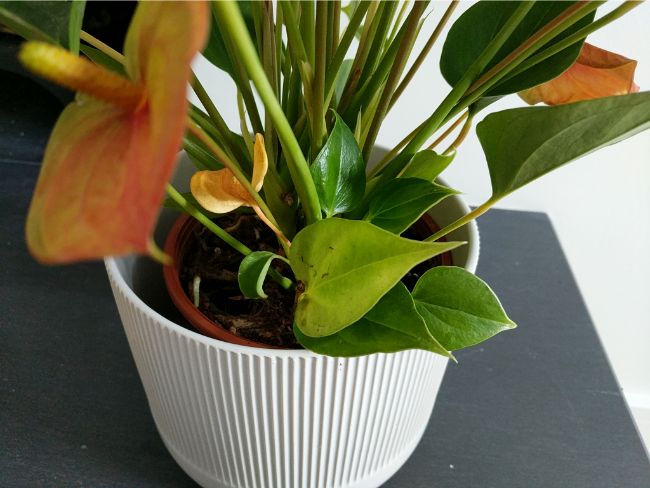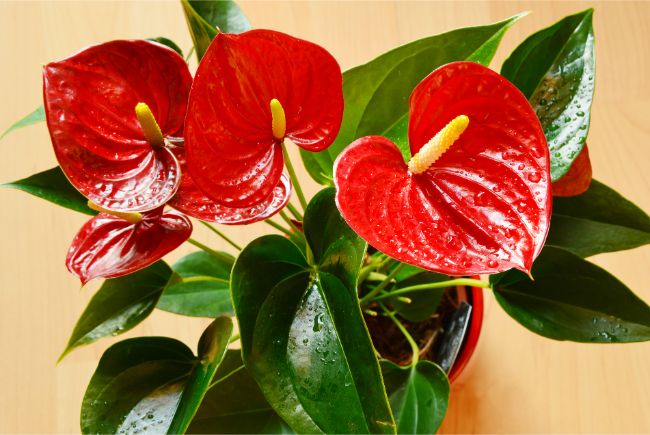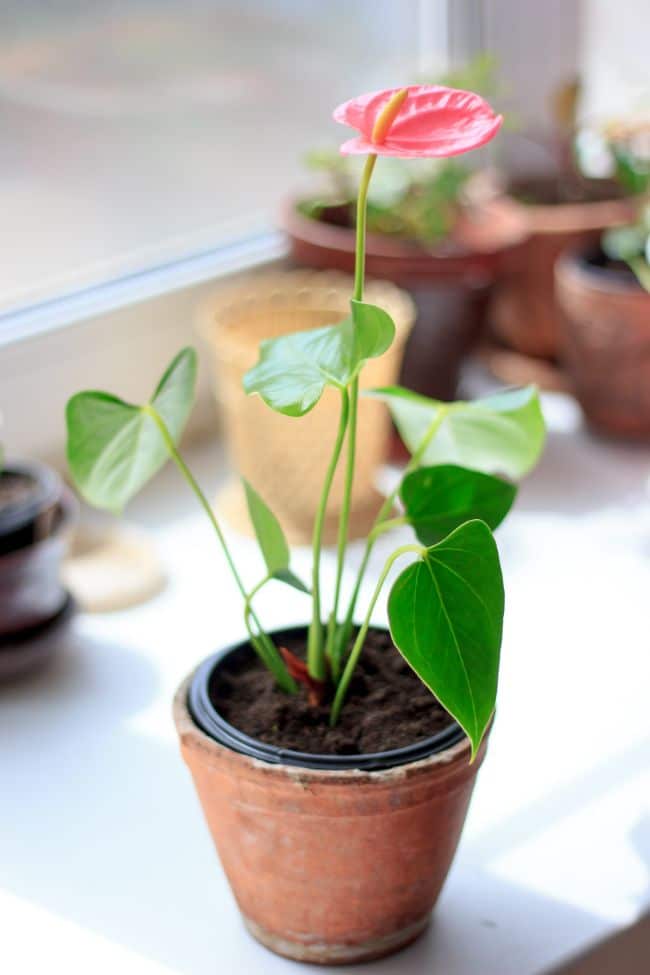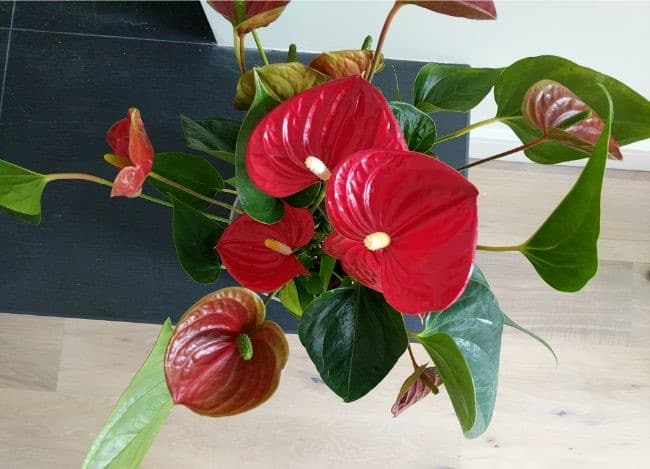Anthurium plants have beautiful, lush foliage and produce bright, crimson flowers. When your Anthurium leaves start turning yellow though, you know you have a problem. Color change in Anthurium plants is not uncommon, especially when the plants are grown in containers. Learning how to identify environmental stress and provide the optimal habitat for your plant will help you fix the problem.
Why are my Anthurium leaves turning yellow? Reasons your Anthurium leaves are turning yellow include over watering, low humidity, excess sunlight, temperature stress, poor soil quality and insufficient fertilizer. You can easily identify and treat the cause to restore your plant to perfect health.
This article will help you identify the reason why your Anthurium has yellow leaves and help you create the optimal habitat for your plant, allowing it to thrive for years to come.
Anthurium Leaves Turning Yellow And What You Can Do
Most Anthurium plants are native to tropical regions, where they generally attach to trees and branches, rather than growing directly in soil. They have recently come into cultivation because of their beautiful glossy green leaves and bright flower production. If kept in optimal conditions, these indoor plants can look great for years.
When the leaves of your Anthurium start to turn yellow, it can significantly impact the beauty of this stunning indoor plant. Learning to identify and remedy common environmental stressors that cause yellow leaves can help you get back the healthy, glossy green foliage you desire.
Environmental Stress And Your Anthurium Plant
The most likely cause of your Anthurium leaves turning yellow is improper watering or excessive light. These two plant stress factors can cause chlorosis, or the break down of chlorophyll in plant leaves.
If given too much water or excess light, less chlorophil is produced in the leaves, and existing chlorophil begins to break down. This produces an unhealthy plant with yellow or brown leaves.
Other plant stressors that can contribute to yellow leaves include improper nutrition, poor soil drainage, and insufficient humidity. Recognizing the difference between a variety of common stressors can help you remedy the situation.

1. Over-Watering Is The Most Common Cause Of Anthurium Leaves Turning Yellow
Anthurium plants require moderately moist soil to stay healthy. The soil needs to stay moist but not wet. This requires attentive monitoring of the plant and soil conditions and attentive watering.
Overwatering your Anthurium will result in poor aeration of the soil, which can lead to root rot and improper water absorption. The stress that this causes your plant will quickly cause yellow or brown leaves and faded flowers and bracts.
However, unlike many indoor plants, Anthurium soil should never dry out. You will need to take a balanced approach when you water your Anthurium, so that the soil stays lightly moist, but not soggy, and avoid standing water, which can create conditions that cause root rot and plant necrosis.
Watering indoor plants correctly is a difficult skill to master and takes a bit of practice. I’ve written a great article that outlines exactly how to tell when your plants need water.
2. Improper Humidity Levels
Anthurium plants are native to tropical regions and prefer high humidity levels. Indoor humidity levels are often varied and inconsistent. If you notice your plant leaves are turning yellow, but you’re sure you’ve been watering your plant carefully, then low humidity might be the issue.
Arid climates naturally have low humidity, and indoor environments usually provide lower humidity than many houseplants would ideally like. This problem gets worse in the winter when we turn on our central heating and close the windows, leading to very dry and humid indoor air.
If you can move your Anthurium plant to a humid environment, like a bathroom, this can help remedy the issue. Alternatively, there are loads of great ways to increase humidity levels for your Anthurium, and all your other indoor plants too.
- Use a humidity tray.
- Group your plants together.
- Use a humidifier.
- Mist your houseplants.
3. Anthurium Leaves Turning Yellow Due To Poor Nutrition
Although Anthuriums don’t need a lot of fertilizer, they do need some. If you haven’t been fertilizing your Anthurium at all, start to apply a water soluble fertilizer once per month. I use this fertilizer for my Anthuriums, with added phosphorus to boost the beautiful blooms of my plant.
Apply the fertilizer at 1/4 of the suggested strength on the instructions. The reason for this is that indoor plants typically need less fertilizer than plants growing outside, and Anthuriums need less fertilizer than some other plants.
Anthuriums just need enough nutrients to grow healthy foliage and blooms. Excess fertilizer can cause damage, causing a toxic buildup of some nutrients and preventing the plant from absorbing others.
If you think you have been applying more fertilizer than suggested above, stop fertilizing, flush the soil out well with plenty of water and leave the plant for a few months without feeding it.

4. Poor Soil Quality
Soil that doesn’t drain properly results in poor aeration of the roots and predisposes your plant to root rot, which will result in your Anthurium leaves turning yellow.
Nutrient deficient soil will also cause symptoms of nutrient deficinecy in your plant including chlorosis of the leaves.
If you think your Anthurim may need repotted into more appropriate soil, an equal mix of peat, pine bark and perlite is ideal for most situations. This will provide a well draining, slightly acidic soil, with just enough nutrient content to keep your Anthurium happy and thriving.
5. Too Much Sunlight Is A Common Cause Of Anthurium Leaves Turning Yellow
Many people think that house plants are happiest in direct, full sunlight. However, this is rarely the case. Most of the popular plants in our homes originate from tropical environments, where they grow beneath the forest canopy, only receiving indirect sunlight.
If you see your Anthurium leaves turning yellow, check the amount of light it is getting. Excessive light will cause the leaves to become progressively more yellow, and in extreme situations, the leaves will develop brown edges or burn marks too.
Move your Anthurium to a location that gets mainly indirect light. A north, west or east facing window is fine, but if your Anthurium is in a room with south facing windows, keep it well away from the window to avoid direct sunlight, or use something to shade it from direct sunlight.
At the other extreme, too little sunlight will usually cause the leaves of your plant to become darker green in color. The main problem with insufficient light is that they tend not to produce blooms in low light conditions. I’ve written an article about the common reasons why Anthuriums fail to bloom here.
6. Temperature Stress
Anthurium plants thrive in temperatures of 70-85°F (21-29°C). Cooler temperatures can cause plant stress and chlorosis in the leaves. Chlorosis is the break down of chlorophyll, and produces spotty leaves with reduced energy production. For flower production and plant root growth, the minimum environmental temperature is 61°F (16°C).
Temperature should always be as constant as possible. The plant should be placed far away from temperature extremes, such as cold air conditioning vents and hot radiators.

Anthurium Plant Care
The most resilient plants are those that have an optimal environment with adequate water, nutrients, sunlight and temperature requirements. To ensure your Anthurium stays healthy and you never have to deal with yellow leaves, follow these quick Anthurium care tips.
- Maintain the temperature at 70-85 °F (21-29 °C) to keep your Anthurium happy.
- Use well-drained soil to prevent root and stem rot (equal parts peat moss, pine bark and perlite is great).
- Bright, indirect light conditions are best.
- Provide high humidity.
- Fertilize once per month during the growing season using 1/4 strength water soluble fertilizer.
- Remove dead foliage to create optimal environment for healthy leaves.
- Container size should be only a little larger than the plant, to reduce the risk of overwatering.
Seasonal Watering Schedule
The Anthurium plant has different water requirements depending on the season. In the winter, your plant will grow much more slowly, if at all, and will require much less water than during the summer.
In addition, higher temperatures in the summer will increase evaporation of water from the soil and transpiration from the leaves. Make sure to check your plant regularly to see if it needs watered before you proceed.
What are some quick tips to help me re-pot my Anthurium?
Water your plant thoroughly before you plant to re-pot. When teasing the roots from the source container, a moist root system is easier to move. Repot to a container only a little larger than the previous one. Preferably choose a porous clay pot with drainage holes and use a well draining, light potting mix such as a mix of peat, pine bark and perlite.
Why aren’t my flowers a crimson red?
Anthurium flowers can change color in response to stress. Improper watering, excess light, too much or too little fertilizer, low humidity and improper temperatures can cause your flowers to become yellow or green. Follow the best Anthurium care practices to ensure your plant thrives!
Last Word
Although there are quite a few reasons why you might find your Anthurium leaves turning yellow, it really isn’t too hard to identify the cause and fix it. Just work through each of the issues outlined above and ensure that you are providing good growing conditions for your plant.
If you’d like to read more about Anthurium care and some related topics, take a look at these articles.

